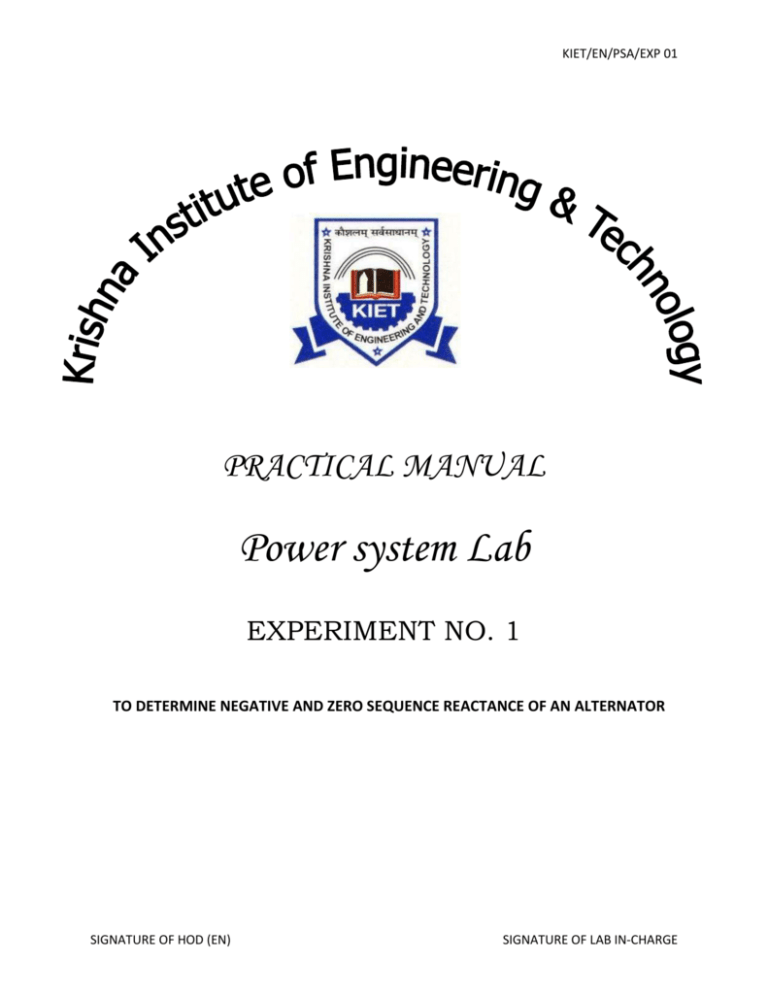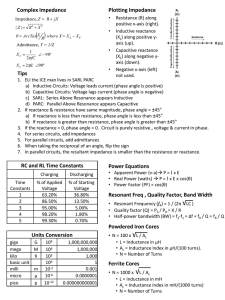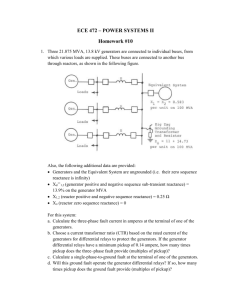To determine negative and zero sequence reactance of an alternator
advertisement

KIET/EN/PSA/EXP 01
PRACTICAL MANUAL
Power system Lab
EXPERIMENT NO. 1
TO DETERMINE NEGATIVE AND ZERO SEQUENCE REACTANCE OF AN ALTERNATOR
SIGNATURE OF HOD (EN)
SIGNATURE OF LAB IN-CHARGE
KIET/EN/PSA/EXP 01
TO DETERMINE NEGATIVE AND ZERO SEQUENCE REACTANCE OF AN ALTERNATOR
OBJECT: To determine negative and zero sequence reactance of an alternator.
APPARATUS USED:
S.No.
1
Name
M. G. Set
2
3
4
5
Ammeter
Voltmeter
Wattmeter
Variac
Type
Range
Shunt
motor 3H.P, 3# 2KVA, 220V dc
+Alternator+Exiter
MI
0-5/10 A
MI
0-75/150/300V
Dynamometer
2.5/5A, 125/250/500V
Single Phase
0-270 V, 5 A
Quantity
1
1
1
1
1
THEORY:
Zero sequence reactance of synchronous machine is defined as the ratio of fundamental
component of reactive armature voltage (due to fundamental component of zero sequence
armature current) to the fundamental component of zero sequence armature current at rated
frequency.
Zero sequence reactance can be measured either by connecting all the three phase of stator
winding of synchronous machine in series or in parallel.
(i)Series connection:
Series connection of all three phase is possible, only when both the terminals of each phase are accessible.
For measuring zero sequence, reactance single phase voltage is applies across the stator winding with
three phases connected in series with the field winding short circuited. The synchronous machine if
desired may be run as an alternator at rated speed. However, the magnitude of zero sequence reactance is
not much affected by the rotation of the machine. As such, rest may be performed with the synchronous
machine stationary. Zero sequence reactance can then be found out by recording the current, applied
voltage and input power and proceeding as per the following.
𝐸
Zero Sequence impedance,𝑍0 = 3𝐼
And zero sequence reactance
𝑃 2
𝑋0 = 𝑍0 √{1 − ( 𝐼 ) }
SIGNATURE OF HOD (EN)
SIGNATURE OF LAB IN-CHARGE
KIET/EN/PSA/EXP 01
Where,
E
I
P
-
Voltage applied to the series circuit of stator phases.
Current applied in the series circuit of stator phase.
Input power to the series circuit
Zero sequence reactance is smallest out of the reactance defined for synchronous machine.
(ii)Parallel Circuit:
Zero sequence reactance can also be determined by connecting all the three phase of stator winding in
parallel. This is adopted, only when four terminals of the stator winding are available with neutral
terminals of the three phases connected together internally and only are terminal for neutral brought out.
Three line terminals of the stator winding are connected in parallel externally. A reduced single-phase
voltage is applied between the line terminals and the neutral terminal. Zero sequence reactance is hardly
affected by the rotation of the machine; as such the test may be performed with the rotor at stand still. In
case, heating is excessive, the machine may be driven at normal speed with the field short circuited.
Readings of voltmeter and ammeter connected in the circuit may be recorded for various values of applied
voltage. Then,
Zero sequence impedance, 𝑍0 = 3𝐸/𝐼
Where E – Voltage applied to the parallel circuit of stator phases.
I - Total test current.
Zero sequence reactance can then be found out as already stated in series test.
Zero sequence reactance, X0 of synchronous machine is the least among the various reactances
assigned to it. Its value is hardly 8 to 10 Percent of the direct – axis synchronous reactance, Xd.
Circuit Diagram:
Fig.1 – Determination of Negative-sequence reactance.
SIGNATURE OF HOD (EN)
SIGNATURE OF LAB IN-CHARGE
KIET/EN/PSA/EXP 01
Fig. 2 – Determination of Zero-sequence Reactance.
PROCEDURE:
1. Connect the circuit as per fig ‘A’ with the three stator phases in series.
2. Ensure that the Variac is at zero position.
3. Switch on the single phase AC supply to the circuit.
4. Apply a reduced voltage to the circuit, so that the current in the series circuit is rated full load
current.
5. Record the readings of all meters connected in the circuit.
6. Switch off the AC supply.
OBSERVATION TABLE:
S. No.
E
I
P
Z0
X0
1.
2.
3.
4.
5.
SIGNATURE OF HOD (EN)
SIGNATURE OF LAB IN-CHARGE
KIET/EN/PSA/EXP 01
RESULT
PRECAUTION
1. Increase the loading current in steps slowly.
2. Note the parameter’s value efficiency & correctly.
3. Measure all parameters with proper suitable range instruments.
VIVA-VOCE
1. What is the typical value of zero sequence reactance in per unit for large rating salient pole
alternator?
2. Do the zero sequence alternator currents produce a rotating field?
3. Out of all the reactance of synchronous machine, which one is the lowest?
INDUSTRIAL APPLICATION:
1.
2.
3.
4.
Determination of the unsymmetrical fault level.
Design of the line-to-line fault detection & protection circuit.
Design of the line-to-Ground fault detection & protection circuit.
Design of the Double line-to-Ground fault detection & protection circuit.
SIGNATURE OF HOD (EN)
SIGNATURE OF LAB IN-CHARGE









